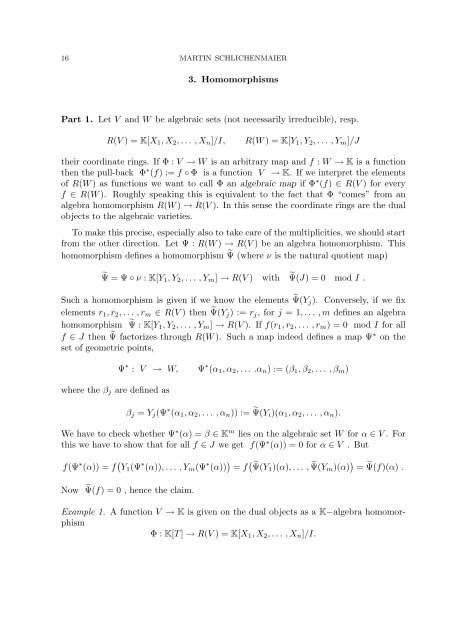Mannheimer Manuskripte 177 gk-mp-9403/3 SOME CONCEPTS OF ...
Mannheimer Manuskripte 177 gk-mp-9403/3 SOME CONCEPTS OF ...
Mannheimer Manuskripte 177 gk-mp-9403/3 SOME CONCEPTS OF ...
- No tags were found...
Create successful ePaper yourself
Turn your PDF publications into a flip-book with our unique Google optimized e-Paper software.
16 MARTIN SCHLICHENMAIER3. HomomorphismsPart 1. Let V and W be algebraic sets (not necessarily irreducible), resp.R(V ) = K[X 1 ,X 2 ,... ,X n ]/I,R(W) = K[Y 1 ,Y 2 ,... ,Y m ]/Jtheir coordinate rings. If Φ : V → W is an arbitrary map and f : W → K is a functionthen the pull-back Φ ∗ (f) := f ◦ Φ is a function V → K. If we interpret the elementsof R(W) as functions we want to call Φ an algebraic map if Φ ∗ (f) ∈ R(V ) for everyf ∈ R(W). Roughly speaking this is equivalent to the fact that Φ “comes” from analgebra homomorphism R(W) → R(V ). In this sense the coordinate rings are the dualobjects to the algebraic varieties.To make this precise, especially also to take care of the multiplicities, we should startfrom the other direction. Let Ψ : R(W) → R(V ) be an algebra homomorphism. Thishomomorphism defines a homomorphism ˜Ψ (where ν is the natural quotient map)˜Ψ = Ψ ◦ ν : K[Y 1 ,Y 2 ,... ,Y m ] → R(V ) with ˜Ψ(J) = 0 mod I .Such a homomorphism is given if we know the elements ˜Ψ(Y j ). Conversely, if we fixelements r 1 ,r 2 ,... ,r m ∈ R(V ) then ˜Ψ(Y j ) := r j , for j = 1,... ,m defines an algebrahomomorphism ˜Ψ : K[Y 1 ,Y 2 ,... ,Y m ] → R(V ). If f(r 1 ,r 2 ,... ,r m ) = 0 mod I for allf ∈ J then ˜Ψ factorizes through R(W). Such a map indeed defines a map Ψ ∗ on theset of geometric points,where the β j are defined asΨ ∗ : V → W, Ψ ∗ (α 1 ,α 2 ,... .α n ) := (β 1 ,β 2 ,... ,β m )β j = Y j (Ψ ∗ (α 1 ,α 2 ,... ,α n )) := ˜Ψ(Y i )(α 1 ,α 2 ,... ,α n ).We have to check whether Ψ ∗ (α) = β ∈ K m lies on the algebraic set W for α ∈ V . Forthis we have to show that for all f ∈ J we get f(Ψ ∗ (α)) = 0 for α ∈ V . Butf(Ψ ∗ (α)) = f ( Y 1 (Ψ ∗ (α)),... ,Y m (Ψ ∗ (α)) ) = f (˜Ψ(Y1 )(α),... , ˜Ψ(Y m )(α) ) = ˜Ψ(f)(α) .Now ˜Ψ(f) = 0 , hence the claim.Exa<strong>mp</strong>le 1. A function V → K is given on the dual objects as a K−algebra homomorphismΦ : K[T] → R(V ) = K[X 1 ,X 2 ,... ,X n ]/I.
















